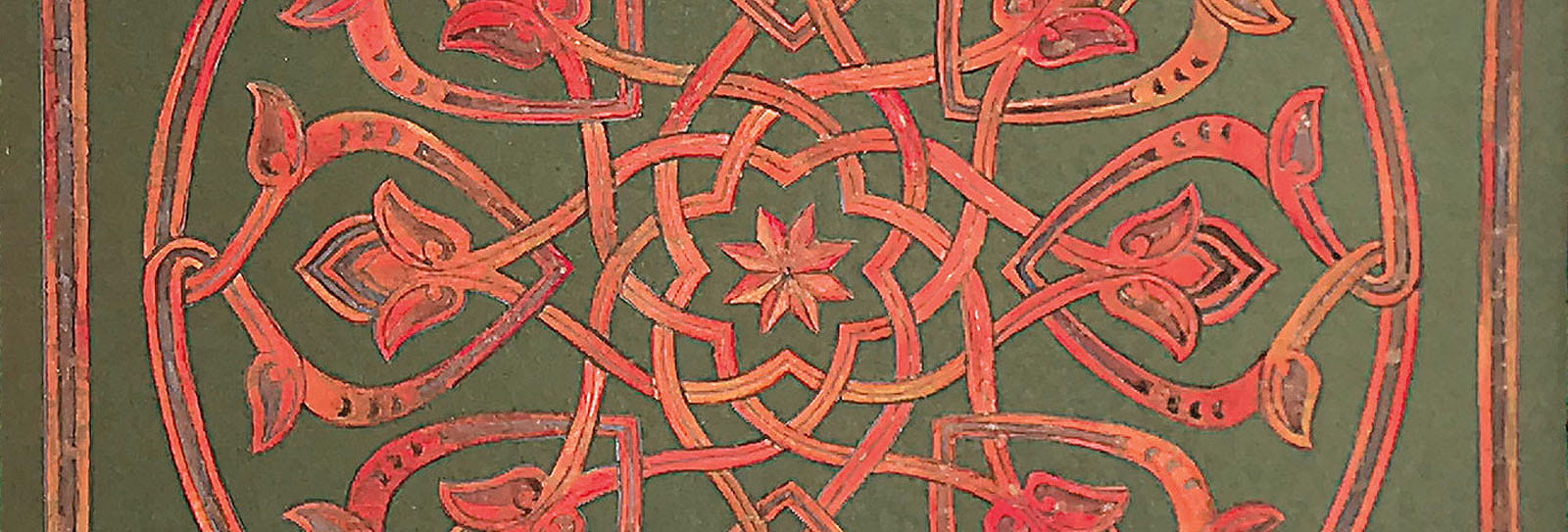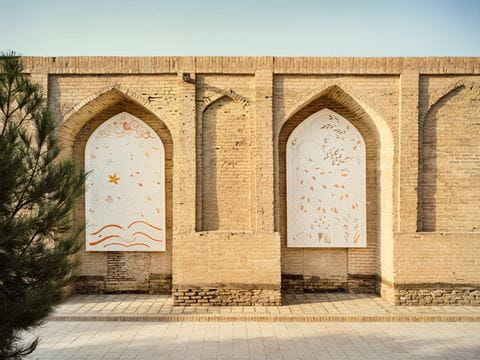
Create Stunning Arabesque Designs of Mamluk Architecture
In part two of this series, we construct a medallion that combines a geometric rosette with an eight-point biomorphic, or arabesque, design. With tracing paper, get ready to learn a 700-year-old patternmaking hack.
In this second exploration into classic Islamic patterns, we turn to one of the stunning marble rosettes that flank the magnificent entrance portal to the mosque-madrasa of Sultan Hassan in Cairo, Egypt, built in the 14th century CE.


These marble-carved medallions seamlessly weave curvilinear geometry into a vesica, or quatrefoil, arabesque composition. The pattern repeats using radial symmetry to produce an interlaced, eight-fold rosette. This is traditionally interpreted to symbolize the four elements of matter—earth, air, fire and water—together with their four properties of dry, wet, hot and cold. These interpretations date to the fourth century BCE, the time of Aristotle, whose writings remained influential among many Muslim thinkers around the time the pattern was carved.
The vegetive motifs, drawn freehand, have their origins in the teardrop motifs called Rumi (Roman) and tepelik (pointed tip, or hilltop) motifs established in Anatolia. The distinctively Mamluk characteristics here can be seen in the symmetrical, spiral embellishments that coil inside the abstract leaves of the Rumi motif.
The mosque-madrasa complex was built between 1356 and 1363, during the Bahri Mamluk period, and it is ranked among the masterpieces of Mamluk architecture. Most Mamluks originated in Central Asia and the Caucasus, and while not free subjects of the Ottoman Empire, they were often educated, and their architecture was sophisticated and cosmopolitan, having within it influences from Byzantium, al-Andalus, North Africa, Central Asia and Persia.
Although this design is underpinned by geometric elements, it is classified as an Arabesque, or biomorphic, design. Both terms refer to patterns that are visual crystallizations of movement, abstract depictions of the vital, dynamic life force of nature that is expressed visually by every culture around our globe, generally using the shapes and materials most intuitive to them. These shapes describe the cycles and patterns inherent in nature, from the microscopic to the macroscopic: protons and neutrons as they spin around atoms; sound as it vibrates through the air; leaves as they uncurl from a fern; the whorls of fingerprints, the growth rings of trees and the currents of oceans.
These flowing, curvilinear patterns thus reflect, alongside geometry and calligraphy, one of the three distinct disciplines of classical Islam’s decorative canon. Within that, there exists a wide variety of regional styles of arabesque, and all follow the same archetypal principles.
In classical Islamic art, symmetry exemplifies perfection and unity, and is thus a reflection of divine qualities: The act of drawing can be undertaken as a meditation upon this harmony in the orders of nature.
In this pattern, stages 1 to 4 are geometric, drawn using a compass and a straightedge. Stages 5 to 9 are biomorphic, drawn freehand, and the repetition of the motifs is rendered using a soft pencil and transferred by tracing paper.
1.
• Across the midpoints of the page, draw a horizontal line. Measure its midpoint and, using the compass, inscribe a circle to fill the page.
• Retaining the same radius, place the compass where the circle intersects the horizontal line on the right (green). Draw a semicircle.
Do the same on the left side.
• Place the compass on each of the four points where the semicircles meet the circle. (The top two are marked in white.) Use the intersecting points of the top and bottom arcs to find the points that define the vertical axis. Note these are above and below your paper, so make sure you allow space. Draw the vertical axis across the circle.
• From the top and bottom intersections of the circle with the vertical axis, draw semicircles (red).
• Draw the diagonal lines by aligning the straightedge with the tips of the petals (blue) and cross the center point.

2.
• Draw a square from the intersections of the circle with the vertical and horizontal axes.
• Draw a set of 8 radial lines from the center point to the edge of the circle by aligning the ruler with each intersection of the square and the semicircular petals (white).
• From the farther intersections of the left petals with the square, draw 1 vertical guideline (red).
• Place the compass point in the center of the diagram and set its radius to meet the vertical guideline. Draw the proportioning circle for the central rosette.
• Without changing the radius, switch the compass to the left side of the circle, where it meets the vertical line. Make small marks where the compass crosses the upper and lower circumference of the proportioning circle.
• Use these points to draw a second, shorter vertical line (turquoise). Use where it meets the horizontal axis to draw, from the center point, a second, smaller proportioning circle.
• Place the compass point on each of the 8 points marked in blue. Set the radius to draw a set of 16 curves whose arcs connect the blue points with the 8 radial lines.

3.
• Expand the compass proportionally to the drawing and repeat the curves from the previous stage at a larger radius to create a channel or ribbon.
• Reduce the compass by the same value and repeat the curves once more to increase the width of the channel/ribbon.

4.
• Using an eraser to remove the lines that flow over one another, reveal the weave of the central rosette.
• Shade where the ribbon passes “under” to emphasize
the interlacing.
• Draw the freehand biomorphic element into one of
the sections (1/16 of the circle) using a 2B pencil.
(Hint: you may want to practice first using tracing paper.)

5.
• Place tracing paper over the biomorphic element. Tape it in place using drafting tape. Trace the drawing using a 3B (very soft) pencil.
• Using the straightedge, trace the vertical line onto the tracing paper. Then fold along this line, keeping the pencil lines on the outside.
• Trace the bilateral symmetry of the biomorphic section on the other side of the fold.
• Unfold the tracing paper and turn it over so that the pencil lines face the original drawing. Aligning it with the main drawing in the each of the sections around the medallion, and keeping it taped in place or held very steady, transfer the pencil lines from the tracing paper onto the main drawing by burnishing (rubbing) the tracing paper with a smooth stone or a spoon.
• Repeat this process for the four corner motifs. (Not shown in these examples.)

6.
• Using a 2B (soft) pencil, redraw the faint lines that have been transferred directly on the page. Start from the side opposite your drawing hand to to reduce smudging.

7.
• Even the weight of the lines, and color in with watered-down ink or watercolors.

8.
• Highlight with a stick of white chalk or pastel.
• Erase the radial lines, axes and all guidelines.
• Add background color if you wish.

You may also be interested in...

“Old Bridge” Story Inspires Lessons in Writing and Community History
History

Art Biennial Reviving the Ancient City of Bukhara, Uzbekistan
History
Culture
Uzbekistan’s inaugural biennial reactivates an ancient stop on the Silk Road through artworks jointly created by international and Uzbek artists.
‘Home’: Arab American National Museum Celebrates 20th Anniversary
Arts
Arab American National Museum Director Diana Abouali says the facility—which is marking its 20th anniversary in 2025—in Dearborn, Michigan, has aimed to create a home for Arab Americans by preserving and presenting the history, culture and contributions of Arab immigrants as well as their native-born children and grandchildren.